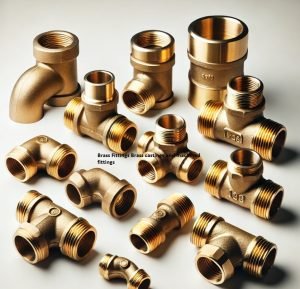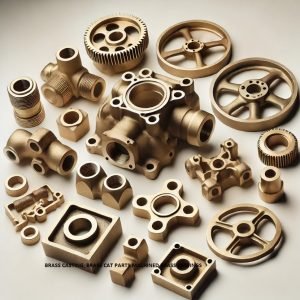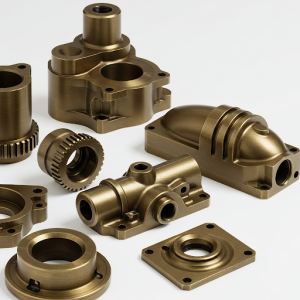Brass Casting, Brass Machined Castings


Brass Casting & Machined Components From INDIA
FOB Price – $11.80/Kg , Click to Order
A1metallics is a leading manufacturer from India with casting foundry offering Brass casting, Bronze casting, Copper casting along with high-end machining capabilities.
With over 3 decades of specialized expertise in brass casting and precision machining, we offer comprehensive manufacturing solutions for complex brass components. Our state-of-the-art foundry facility is equipped with both sand and gravity die casting capabilities, handling castings from 100 grams to 50 kilograms with exceptional dimensional accuracy. We maintain precise control over chemical compositions across various brass grades including CZ 114 C36000 C83600, C85800, and specialized red brass alloys.We offer Brass Screw machine parts, Brass CNC machined parts, Brass CNC machined components from castings as well as bars.
Our advanced machining center features multiple CNC machines including 4-axis latest CNC turning centers, enabling us to achieve tolerances up to ±0.02mm. We specialize in high-precision machining of intricate components for electrical, marine, and industrial applications. Our in-house metallurgical laboratory ensures consistent quality through spectrographic analysis, mechanical testing, and dimensional inspection using CMM equipment. From prototype development to high-volume production runs, we deliver cast and machined brass components that meet international standards including ASTM, BS, DIN, and JIS specifications.We offer a wide range of Brass Castings, Machined casting, Cast and Machined Brass Parts, Cast and Machined Brass Components. We also make components from CDA 360 C36000 Brass free machining as well as casting grades. We also offer Gunmetal )red Brass) fittings and castings.
Brass Alloy Standards & Compositions
Red Brass Alloys
| Standard/Grade | Composition | Properties & Applications |
|---|---|---|
| C83600 | Cu 85%, Sn 5%, Pb 5%, Zn 5% | High corrosion resistance, plumbing fixtures |
| C83400 | Cu 81%, Sn 3%, Pb 7%, Zn 9% | Excellent castability, valve bodies |
| C83800 | Cu 83%, Sn 4%, Pb 6%, Zn 7% | High pressure resistance, steam fittings |
| C83500 | Cu 86%, Sn 5%, Pb 5%, Zn 4% | Superior wear resistance, bearings |
British Standards (BS)
| BS Number | Composition | Properties |
|---|---|---|
| CZ121 (BS 2874) | Cu 58%, Zn 39%, Pb 3% | Free cutting brass, excellent machinability |
| CZ114 (BS 2874) | Cu 57%, Zn 41%, Pb 2% | High-grade casting brass |
| PB102 (BS 2872) | Cu 63%, Zn 35%, Pb 2% | High tensile brass, good for hot pressing |
| HTB1 (BS 2875) | Cu 59%, Zn 39%, Sn 1%, Pb 1% | High tensile brass casting |
| SCB3 (BS 1400) | Cu 87%, Sn 7%, Pb 3%, Zn 3% | Sand casting brass, high strength |
US Standards (ASTM/UNS)
| UNS Number | Composition | Properties |
|---|---|---|
| C85800 | Cu 57%, Zn 40%, Pb 2%, Sn 1% | High-strength yellow brass casting |
| C85200 | Cu 72%, Zn 27%, Pb 1% | High copper brass for electrical |
| C85500 | Cu 59%, Zn 38%, Sn 1%, Pb 2% | General purpose casting brass |
| C84400 | Cu 81%, Zn 9%, Sn 2%, Pb 8% | Semi-red brass, good machinability |
| C84800 | Cu 76%, Zn 16%, Sn 3%, Pb 5% | Semi-red brass, pressure tight |
German Standards (DIN)
| DIN Number | Composition | Properties |
|---|---|---|
| CuZn40Pb2 | Cu 58%, Zn 40%, Pb 2% | Standard casting brass |
| CuZn33Pb2 | Cu 65%, Zn 33%, Pb 2% | High copper content casting brass |
| CuZn35Pb2 | Cu 63%, Zn 35%, Pb 2% | Medium-duty machining brass |
| CuZn37Pb0.5 | Cu 62.5%, Zn 37%, Pb 0.5% | Low-lead architectural brass |
| RG5 | Cu 85%, Sn 5%, Zn 5%, Pb 5% | Red brass for pressure applications |
Japanese Standards (JIS)
| JIS Number | Composition | Properties |
|---|---|---|
| CAC203 | Cu 58%, Zn 39%, Pb 3% | High-grade casting brass |
| CAC406 | Cu 84%, Sn 4%, Pb 6%, Zn 6% | Bronze casting alloy |
| CAC201 | Cu 62%, Zn 36%, Pb 2% | General purpose brass casting |
| CAC502 | Cu 88%, Sn 6%, Zn 4%, Pb 2% | High-strength red brass |
| CAC704 | Cu 80%, Sn 10%, Pb 10% | High-tin red brass for bearings |
European Standards (EN)
| EN Number | Composition | Properties |
|---|---|---|
| CW617N | Cu 58%, Zn 40%, Pb 2% | Standard European brass |
| CW614N | Cu 57%, Zn 39%, Pb 3% | Free-machining brass |
| CW612N | Cu 63%, Zn 35%, Pb 2% | Forging brass |
| CC491K | Cu 85%, Sn 5%, Zn 5%, Pb 5% | Red brass casting alloy |
| CC493K | Cu 87%, Sn 7%, Pb 4%, Zn 2% | High-grade gunmetal |
Casting Methods
- Sand Casting
- Green sand casting
- Dry sand casting
- Shell molding
- CO2 process
- Die Casting
- Hot chamber die casting
- Cold chamber die casting
- Gravity die casting
- Investment Casting
- Lost wax process
- Shaw process
- Continuous Casting
- Horizontal continuous casting
- Vertical continuous casting
- Centrifugal Casting
- True centrifugal casting
- Semi-centrifugal casting
Typical Components & Applications
Plumbing & Valves
- Ball valves
- Gate valves
- Pipe fittings
- Water meters
- Pressure regulators Water Mixers,
Electrical Components
- Terminal blocks
- Cable glands
- Switchgear components
- Bus bars
- Electrical Connectors, Terminal bars
Industrial Equipment
- Pump components
- Gear housings
- Bearing cages
- Bushings
Marine Applications
- Propellers
- Ship fittings
- Marine hardware
- Underwater components
Machining Specifications
General Tolerances
| Dimension Range | Standard Tolerance | Precision Tolerance |
|---|---|---|
| Up to 10mm | ±0.1mm | ±0.02mm |
| 10-30mm | ±0.2mm | ±0.05mm |
| 30-100mm | ±0.3mm | ±0.1mm |
Surface Finish
| Process | Achievable Ra (μm) |
|---|---|
| Turning | 0.8-3.2 |
| Milling | 1.6-6.3 |
| Grinding | 0.2-1.6 |
| Polishing | 0.1-0.4 |
Machining Equipment
- CNC Turning Centers
- 2-axis lathes
- Multi-axis turning centers
- Swiss-type machines
- CNC Machining Centers
- 3-axis vertical mills
- 4/5-axis machining centers
- High-speed machining centers
- Grinding Equipment
- Surface grinders
- Cylindrical grinders
- Centerless grinders
Surface Finishing Methods
- Mechanical Finishing
- Polishing
- Buffing
- Shot blasting
- Vibratory finishing
- Chemical Finishing
- Bright dipping
- Chemical polishing
- Passivation
- Plating
- Chrome plating
- Nickel plating
- Gold plating
Quality Control & Testing
- Chemical composition analysis
- Mechanical property testing
- Dimensional inspection
- Non-destructive testing
- Pressure testing
- Hardness testing
- Metallographic examination
BRASS COMPARISON
| China | Germany | Europe | International | USA | Japan | |||
|---|---|---|---|---|---|---|---|---|
| GB | Symbol | No. | Symbol | No. | Symbol | No. | No. | JIS |
| TU2 | OF-Cu | 2.004 | Cu-OFE | CW009A | Cu-OF | C10100 | C101H | – |
| – | SF-Cu | 2.007 | Cu-HCP | CW021A | – | C10300 | – | – |
| T2 | E-Cu58 | 2.0065 | Cu-ETP | CW004A | Cu-ETP | C11000 | C1100 | – |
| TP2 | SF-Cu | 2.009 | Cu-DHP | CW024A | Cu-DHP | C12200 | C1220 | – |
| TP1 | SW-Cu | 2.0076 | Cu-DLP | CW023A | Cu-DLP | C12000 | C1201 | – |
| H96 | CuZn5 | 2.022 | CuZn5 | CE500L | CuZn5 | C21000 | C2100 | – |
| H90 | CuZn10 | 2.023 | CuZn10 | CW501L | CuZn10 | C22000 | C2200 | – |
| H85 | CuZn15 | 2.024 | CuZn15 | CW502L | CuZn15 | C23000 | C2300 | – |
| H80 | CuZn20 | 2.025 | CuZn20 | CW503L | CuZn20 | C24000 | C2400 | – |
| H70 | CuZn30 | 2.0265 | CuZn30 | CW505L | CuZn30 | C26000 | C2600 | – |
| H65 | CuZn36 | 2.0335 | CuZn36 | CW507L | CuZn36 | C27700 | C2700 | – |
| H63 | CuZn37 | 2.0321 | CuZn37 | CW508L | CuZn37 | C27200 | C2720 | – |
| HPb63-3 | CuZn36Pb1.5 | 2.0331 | CuZn35Pb1 | CW600N | CuZn35Pb1 | C34000 | C3501 | – |
Additional Alloy Types:
| QBe2 | CuBe2 | – | – | – | CuBe2 | C17200 | C1720 | – |
| ZQSn5-5-5 | GB-CuSn5ZnPb | – | – | – | GCuPbSn5Zn | C83600 | BCin6 | – |
Sand Casting Capabilities:
- Maximum Size: 1,500 mm × 1000 mm × 500 mm
- Weight Range: 0.5 kg – 500 kg
- Annual Capacity: 5,000 tons – 6,000 tons
We also offer from our foundry- High quality Copper castings and Bronze casting and LG2 Bronze Gunmetal castings.
Q&A on Brass Casting and Machined Brass Casting
1. What is Brass Casting? Brass Casting is a manufacturing process where molten Brass, an alloy primarily composed of copper and zinc, is poured into a mold to create components of specific shapes and sizes. This method is widely used to produce intricate and durable parts for various industries.
2. What are the common methods of Brass Casting? The primary methods of Brass Casting include:
- Sand Casting: Utilizes sand molds, making it economical for producing complex shapes.
- Investment Casting: Employs wax patterns coated with ceramic material to achieve high-precision components.
- Die Casting: Involves forcing molten Brass into metal molds under high pressure, suitable for mass production.
- Vacuum Casting: Uses a vacuum to draw molten Brass into the mold, reducing air inclusions and enhancing quality.
3. What is Machined Brass Casting? Machined Brass Casting refers to Brass components that have been cast into a near-net shape and then subjected to machining processes. This approach ensures precise dimensions, tight tolerances, and superior surface finishes, making the parts suitable for high-performance applications.
4. What are the advantages of using Brass in casting? Brass offers several benefits in casting, including:
- Corrosion Resistance: Ideal for components exposed to moisture and various environments.
- Excellent Machinability: Facilitates easy machining into complex shapes with fine details.
- Aesthetic Appeal: Possesses a natural golden hue, making it suitable for decorative applications.
- Good Thermal and Electrical Conductivity: Beneficial for components requiring efficient heat or electrical transfer.
5. Which industries commonly utilize Brass Castings? Brass Castings are prevalent in various sectors, including:
- Automotive: Components like gears, valves, and fittings.
- Aerospace: Parts requiring strength and corrosion resistance.
- Plumbing and Hydraulics: Fittings, valves, and connectors due to Brass’s durability and resistance to corrosion.
- Electrical and Electronics: Connectors, terminals, and switches leveraging Brass’s conductive properties.
- Architecture and Construction: Decorative elements and hardware benefiting from Brass’s aesthetic and durable nature.
6. What are the typical steps involved in the Brass Casting process? The Brass Casting process generally includes:
- Pattern Creation: Designing a replica of the final product.
- Mold Preparation: Forming a mold around the pattern using materials like sand or ceramic.
- Melting: Heating Brass alloy to its melting point.
- Pouring: Introducing molten Brass into the mold.
- Cooling: Allowing the Brass to solidify within the mold.
- Finishing: Removing the casting from the mold and performing additional machining or surface treatments as needed.
7. What factors should be considered when designing a Brass Casting? Key considerations include:
- Uniform Wall Thickness: To prevent uneven cooling and potential defects.
- Draft Angles: Incorporating slight angles to facilitate easy removal from the mold.
- Fillets: Adding rounded corners to reduce stress concentrations.
- Shrinkage Allowance: Accounting for the slight reduction in size as Brass cools and solidifies.
8. What are common defects in Brass Casting, and how can they be prevented? Common defects include:
- Porosity: Caused by trapped gases; preventable by ensuring proper venting and mold design.
- Shrinkage: Occurs due to improper cooling; addressed by designing appropriate risers and cooling rates.
- Cold Shuts: Happen when two streams of molten metal do not fuse properly; avoidable by maintaining adequate pouring temperatures and speeds.
9. How does machining enhance Brass Castings? Machining refines Brass Castings by:
- Achieving Precise Dimensions: Ensuring components meet exact specifications.
- Improving Surface Finish: Providing smooth surfaces for better aesthetics and functionality.
- Creating Complex Features: Enabling intricate details that casting alone might not accomplish.
10. What surface finishes are available for Brass Castings? Various finishes include:
- Polishing: Achieves a smooth, shiny surface.
- Plating: Applying a layer of another metal, such as nickel or chrome, for enhanced appearance and corrosion resistance.
- Patination: Developing a controlled oxide layer for an antique or artistic look.
- Powder Coating: Adding a protective and decorative layer available in various colors.
11. What safety precautions are necessary during the Brass Casting process? Essential safety measures include:
- Personal Protective Equipment (PPE): Wearing heat-resistant gloves, face shields, safety goggles, and flame-resistant clothing.
- Ventilation: Ensuring adequate airflow to dissipate fumes generated during melting.
- Equipment Inspection: Regularly checking crucibles and molds for damage or wear.
- Fire Safety: Keeping fire extinguishers and emergency response equipment nearby in case of accidents.
This Q&A section provides in-depth insights into Brass Casting and Machined Brass Casting, helping customers and industry professionals understand the process, benefits, and applications of Brass components.
We also offer Brass casting , Bronze Saddles Pipe Saddles Gunmetal Pipe Saddles Ferrules Straps , Permanent mold Bronze casting, high conductivity Copper casting, Phosphor Bronze Casting, Silicon bronze Casting Gunmetal Casting Gunmetal Casting Foundry from our state of the art Bronze, Copper and Brass casting foundry in India.
Feel free to email us or Whatsapp us for your quotes on Brass casting, Brass CNC machined castings and Copper alloy- Bronze castings.


